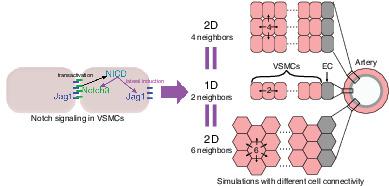当前位置:
X-MOL 学术
›
Int. J. Numer. Method. Biomed. Eng.
›
论文详情
Our official English website, www.x-mol.net, welcomes your
feedback! (Note: you will need to create a separate account there.)
Lateral induction limits the impact of cell connectivity on Notch signaling in arterial walls.
International Journal for Numerical Methods in Biomedical Engineering ( IF 2.2 ) Pub Date : 2020-02-26 , DOI: 10.1002/cnm.3323 Tommaso Ristori 1, 2, 3 , Oscar M J A Stassen 1, 2 , Cecilia M Sahlgren 1, 2, 3 , Sandra Loerakker 1, 3
International Journal for Numerical Methods in Biomedical Engineering ( IF 2.2 ) Pub Date : 2020-02-26 , DOI: 10.1002/cnm.3323 Tommaso Ristori 1, 2, 3 , Oscar M J A Stassen 1, 2 , Cecilia M Sahlgren 1, 2, 3 , Sandra Loerakker 1, 3
Affiliation

|
It is well known that arteries grow and remodel in response to mechanical stimuli. Vascular smooth muscle cells are the main mediators of this process, as they can switch phenotype from contractile to synthetic, and vice‐versa, based on the surrounding bio‐chemo‐mechanical stimuli. A correct regulation of this phenotypic switch is fundamental to obtain and maintain arterial homeostasis. Notch, a mechanosensitive signaling pathway, is one of the main regulators of the vascular smooth muscle cell phenotype. Therefore, understanding Notch dynamics is key to elucidate arterial growth, remodeling, and mechanobiology. We have recently developed a one‐dimensional agent‐based model to investigate Notch signaling in arteries. However, due to its one‐dimensional formulation, the model cannot be adopted to study complex nonsymmetrical geometries and, importantly, it cannot capture the realistic “cell connectivity” in arteries, here defined as the number of cell neighbors. Notch functions via direct cell‐cell contact; thus, the number of cell neighbors could be an essential feature of Notch dynamics. Here, we extended the agent‐based model to a two‐dimensional formulation, to investigate the effects of cell connectivity on Notch dynamics and cell phenotypes in arteries. The computational results, supported by a sensitivity analysis, indicate that cell connectivity has marginal effects when Notch dynamics is dominated by the process of lateral induction, which induces all cells to have a uniform phenotype. When lateral induction is weaker, cells exhibit a nonuniform phenotype distribution and the percentage of synthetic cells within an artery depends on the number of neighbors.
中文翻译:

横向诱导限制了细胞连通性对动脉壁Notch信号传导的影响。
众所周知,动脉响应于机械刺激而生长和重塑。血管平滑肌细胞是该过程的主要介质,因为它们可以根据周围的生物化学机械刺激将表型从收缩型转变为合成型,反之亦然。这种表型转换的正确调节是获得和维持动脉稳态的基础。Notch是一种机械敏感的信号通路,是血管平滑肌细胞表型的主要调节因子之一。因此,了解Notch动力学是阐明动脉生长,重塑和力学生物学的关键。我们最近开发了一种基于代理的一维模型来研究动脉中的Notch信号。但是,由于其为一维形式,因此无法采用该模型来研究复杂的非对称几何形状,并且 重要的是,它无法捕获动脉中实际的“细胞连通性”,此处定义为细胞邻居的数量。槽口功能通过直接的电池间接触实现;因此,细胞邻居的数量可能是Notch动力学的基本特征。在这里,我们将基于代理的模型扩展为二维公式,以研究细胞连通性对动脉中Notch动力学和细胞表型的影响。计算结果得到敏感性分析的支持,表明当Notch动力学受侧向诱导过程支配时,细胞连通性具有边际效应,该诱导过程诱导所有细胞具有统一的表型。当横向诱导较弱时,细胞表现出不均匀的表型分布,并且动脉内合成细胞的百分比取决于邻居的数量。它无法捕获动脉中实际的“细胞连通性”,此处定义为细胞邻居的数量。槽口功能通过直接的电池间接触实现;因此,细胞邻居的数量可能是Notch动力学的基本特征。在这里,我们将基于代理的模型扩展为二维公式,以研究细胞连通性对动脉中Notch动力学和细胞表型的影响。计算结果得到敏感性分析的支持,表明当Notch动力学受侧向诱导过程支配时,细胞连通性具有边际效应,该诱导过程诱导所有细胞具有统一的表型。当横向诱导较弱时,细胞表现出不均匀的表型分布,并且动脉内合成细胞的百分比取决于邻居的数量。它无法捕获动脉中真实的“细胞连通性”,此处定义为细胞邻居的数量。槽口功能通过直接的电池间接触实现;因此,细胞邻居的数量可能是Notch动力学的基本特征。在这里,我们将基于代理的模型扩展为二维公式,以研究细胞连通性对动脉中Notch动力学和细胞表型的影响。计算结果得到敏感性分析的支持,表明当Notch动力学受侧向诱导过程支配时,细胞连通性具有边际效应,该诱导过程诱导所有细胞具有统一的表型。当横向诱导较弱时,细胞表现出不均匀的表型分布,并且动脉内合成细胞的百分比取决于邻居的数量。
更新日期:2020-02-26
中文翻译:

横向诱导限制了细胞连通性对动脉壁Notch信号传导的影响。
众所周知,动脉响应于机械刺激而生长和重塑。血管平滑肌细胞是该过程的主要介质,因为它们可以根据周围的生物化学机械刺激将表型从收缩型转变为合成型,反之亦然。这种表型转换的正确调节是获得和维持动脉稳态的基础。Notch是一种机械敏感的信号通路,是血管平滑肌细胞表型的主要调节因子之一。因此,了解Notch动力学是阐明动脉生长,重塑和力学生物学的关键。我们最近开发了一种基于代理的一维模型来研究动脉中的Notch信号。但是,由于其为一维形式,因此无法采用该模型来研究复杂的非对称几何形状,并且 重要的是,它无法捕获动脉中实际的“细胞连通性”,此处定义为细胞邻居的数量。槽口功能通过直接的电池间接触实现;因此,细胞邻居的数量可能是Notch动力学的基本特征。在这里,我们将基于代理的模型扩展为二维公式,以研究细胞连通性对动脉中Notch动力学和细胞表型的影响。计算结果得到敏感性分析的支持,表明当Notch动力学受侧向诱导过程支配时,细胞连通性具有边际效应,该诱导过程诱导所有细胞具有统一的表型。当横向诱导较弱时,细胞表现出不均匀的表型分布,并且动脉内合成细胞的百分比取决于邻居的数量。它无法捕获动脉中实际的“细胞连通性”,此处定义为细胞邻居的数量。槽口功能通过直接的电池间接触实现;因此,细胞邻居的数量可能是Notch动力学的基本特征。在这里,我们将基于代理的模型扩展为二维公式,以研究细胞连通性对动脉中Notch动力学和细胞表型的影响。计算结果得到敏感性分析的支持,表明当Notch动力学受侧向诱导过程支配时,细胞连通性具有边际效应,该诱导过程诱导所有细胞具有统一的表型。当横向诱导较弱时,细胞表现出不均匀的表型分布,并且动脉内合成细胞的百分比取决于邻居的数量。它无法捕获动脉中真实的“细胞连通性”,此处定义为细胞邻居的数量。槽口功能通过直接的电池间接触实现;因此,细胞邻居的数量可能是Notch动力学的基本特征。在这里,我们将基于代理的模型扩展为二维公式,以研究细胞连通性对动脉中Notch动力学和细胞表型的影响。计算结果得到敏感性分析的支持,表明当Notch动力学受侧向诱导过程支配时,细胞连通性具有边际效应,该诱导过程诱导所有细胞具有统一的表型。当横向诱导较弱时,细胞表现出不均匀的表型分布,并且动脉内合成细胞的百分比取决于邻居的数量。









































 京公网安备 11010802027423号
京公网安备 11010802027423号